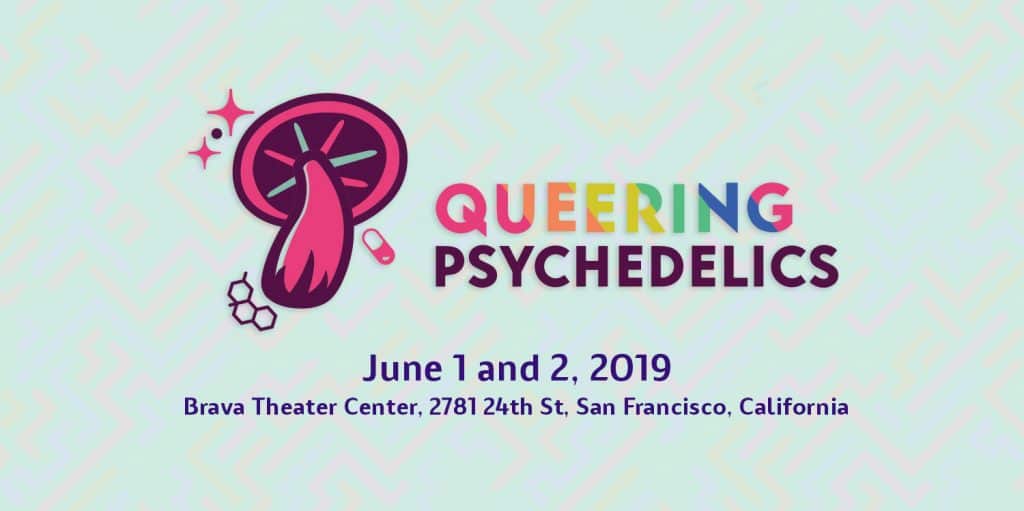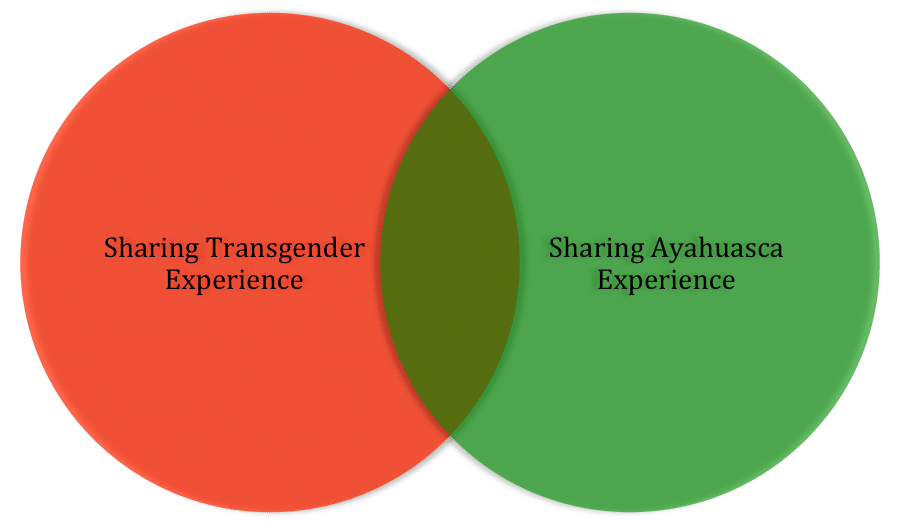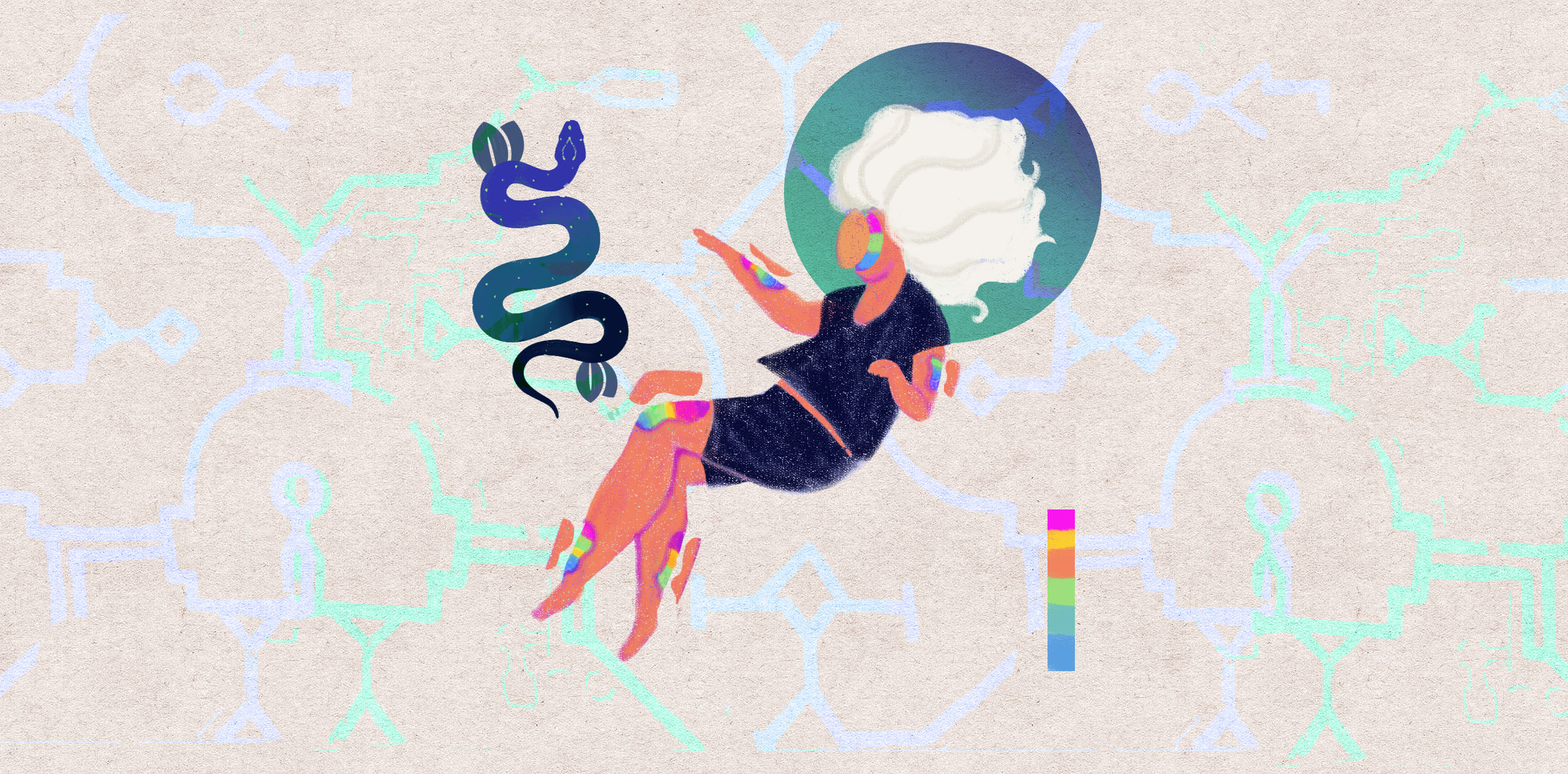Most journeys start with one step, but the beginning of my transgender journey began with an emphatic, “No!”
In the dark finale of an ayahuasca ceremony, I had asked to see the deepest part of myself. The deepest part of me conjured an image of me as a beautiful, shining woman. Everywhere I looked it was Woman-Me. She was dancing, singing, moving effortlessly through the darkness. She multiplied and spread, kaleidoscoping my vision in an infinite twirling presence of laughter and joy. She looked at me with a brilliant smile, a smile I had yet to experience in my life, and held her hands out to me in invitation.
“This is you,” ayahuasca said.
I freaked out. I thought, no, please, no don’t show me that. I knew it wasn’t a metaphor, but a long-buried part of myself. I wanted to box her up, bury her again, and hide. The ceremony ended, the lights came on, and then the real journey began.
Who I Was (The Backstory)
At the time of the revelation, I had lived as an out gay man for over a decade. My main work was globally supporting HIV programming for gender and sexually diverse (GSD) people.
I prefer the GSD term because it includes a wide spectrum. It can include, but is not limited to, gay, lesbian, bisexual, transgender, and intersex (LGBTI) people. But GSD can also include those who do not adhere to these categorical identifications due to their colonial and/or white-dominant histories. Examples include, but are not limited to, same-gender loving in North American black communities, the global reclamation of the “queer” identity, Hijra of India, two-spirit Native Americans, and others.
Wanna Play a Game?
Though I met the initial Woman-Me vision with fear and avoidance, the subsequent four years of integration was playful.
Though I met the initial Woman-Me vision with fear and avoidance, the subsequent four years of integration was playful. I have synthesized six lessons on how to approach gender and sexual diversity exploration through my own journey of ayahuasca integration.
These lessons are for those in a similar process of discovery. Facilitators of ayahuasca and other psychedelic ritualized uses and research can also use these lessons to create safe spaces and interactions with their participants who may or may not identify as GSD people.
Come on, let’s play!
Lesson 1: Create safe spaces to discover diamonds in the darkness.
I pondered what I saw when I was safe and in my own space. Visions can be tricky. When are they literal and when are they metaphor? My approach to interpreting ayahuasca and other psychedelic visions is rooted in my training in shamanic journeying. Shamanic journeying is practiced in different ways across the world to gain answers to questions in the spirit world or non-ordinary reality. Ingestion of ayahuasca produces a similar effect to shamanic journeying. In my experience, non-ordinary reality, like dreams, largely operates in symbols. For example, in one vision, I saw a tall tree and then was taken to the roots. The roots were rotting and the ground was falling away. I interpreted that as a need to take care of my home life and needing grounding.
Usually, I can differentiate between literal and metaphorical messages in two steps: First, I ask ayahuasca if the message is meant to be literal and then, critically, I gauge my mental and physical reaction. This is why, just like in shamanic journeying, being clear about the question is so important. The question is the key to interpreting the vision.
Had I forgotten the treasure map to these hidden parts of myself? What is beneath the fear that I experienced? The answer to the latter question was shame.
For the Woman-Me vision, I first made the request, “Show me the deepest part of myself,” and my reaction was fear and denial. Had I forgotten the treasure map to these hidden parts of myself? What is beneath the fear that I experienced? The answer to the latter question was shame. Dr. Brene’ Brown, compassion and shame expert, states there are three ingredients to grow shame: secrecy, silence, and judgment. I had all three in droves; first, I had to address the shame.
I created safe spaces for myself to release the shame by holding rituals for myself, speaking more openly with trusted friends, and creating and singing power songs.

Lesson 2: Who can help me to look into this blind spot?
At some point in my life, Child-Me hid a secret from others and myself. Child-Me hid this secret very well, most likely out of shame and fear of reprisal. Hmm, what is the best hiding place? I know! The place of I don’t know that I don’t know, or “the blind spot.” Putting secrets in the blind spot means that I won’t see them and that I will eventually forget that I ever saw them, especially as a child.
By definition, I cannot look into my blind spot on my own. It’s my blind spot! I have a personal relationship with the spirit of ayahuasca. Ayahuasca has earned my trust. Ayahuasca visions in the past had been spot on and had supported me in finding peace and acceptance with myself. So, with this trust, I gave her permission to help me to look in that place I cannot see.
Then, in the subsequent four years of discovery, I sought advice and support from trusted transgender friends and colleagues in exploring this unknown territory. It turns out that everyone around me had inklings that I was transgender way before I even knew myself. They could see my blind spot and were waiting for me to give them permission to talk about it.
I intentionally use the word “trust” here, as it invokes a safe space for exploration.

Come join us in Queering Psychedelics! Buy tickets here
Lesson 3: Focus on YOU, not the visions (or others’ projections)
At the time, I was the only sexually diverse person I knew working with ayahuasca. Resources online were scant, and still are, but growing (thanks Chacruna.net!). And I constantly remind myself that I do the best I can with each situation.
I met resistance to gender diversity, even among people I knew well and who were sexually diverse. I’ve worked with a gay male ayahuasca facilitator, but he made no effort to use my preferred pronoun at the time (“they”). He also told me to stop asking people in his ceremonial gatherings to use “friend” instead of gendered spiritual terms of endearment (e.g., brother or sister).
The ceremony facilitator where I had the Woman-Me revelation was a friend, but she identified as heterosexual, cisgender woman. I didn’t feel comfortable sharing this revelation. In a previous ceremony, I told her I had a vision I was a transgender sex worker in India. She said, “Oh,” with wide eyes, an awkward silence ensued, and she turned around and began a different conversation with someone else. I was disappointed with her response and what I felt to be discomfort with the topic. I expected more engagement, questions, listening, as she had said she was there to support integration. She just wasn’t the right person at the time, and that’s okay.
I have rarely shared how I came to the realization that I may be a transgender woman with people who weren’t familiar with ayahuasca. And, in ayahuasca communities, I rarely shared my queer experiences in predominantly cisgender, heterosexual integration sessions after ceremonies. The Vin diagram of my queer ayahuasca experiences was a muddy hue that I could rarely clarify through sharing.
This experience shows that we need more safe spaces for GSD people to integrate and share for their ayahuasca and psychedelic experiences.
To integrate these gender teachings, I focused on the transgender part with people who got me: my transgender friends and allies. That was the part that needed attention, and I dropped the need to share that part of myself in ayahuasca integration circles. This experience shows that we need more safe spaces for GSD people to integrate and share for their ayahuasca and psychedelic experiences.

Lesson 4: Learn to fly with like-feathered birds
Later, my work took me to South Africa where I supported national research on HIV medication access for transgender people. I managed research in Johannesburg, including Soweto, and I made friends with transgender women there. It was through these connections, and the intimate aspects of qualitative interviewing, that I mustered the courage to step into my authenticity.
I began dressing how I wanted to, as a woman, for these interviews with transgender women. I was surprised to feel waves of acceptance, affirmation, and authenticity. I had only really experienced these waves in ayahuasca and other psychedelic settings. I thought, “These feelings can be experienced in life outside ceremony? Wow!”These transgender women showed me how to be me, be Dee.
Lesson 5: Take a break, integrate, participate
I have rarely experienced this Woman-Me in ayahuasca settings since then. Sometimes I asked to explore again, but ayahuasca wouldn’t play along. This was a sign to do the work outside of ceremony.
I started taking longer and longer breaks from drinking ayahuasca. I took a yearlong break to integrate these and other revelations. My approach was one of play, and experiential; the best gender experience game I knew was drag performance.
I taught myself to paint my face in avant-garde styles. My performance style was also unique (no Lady Gaga lip syncing). I played the djembe (a West African drum) and sang empowering medicine songs that I had received from plants and ayahuasca through ceremonies. At my first gig, the Oklahoma City queer bar I performed at erupted with love and praise. People shared that the songs inspired them to do things they had been too scared to do before.
Healing happens for all when I share my playful process.

The one experience that helped me to embody my transgender identity came in the form of a game that my helping spirits taught me. I prayed to my known and trusted helping spirits and asked for help on how I can truly know and experience me.
“Today, we invite you to play a game. This game will last for one day. Just today, play that you are a woman pretending to be a man.”
Their response: “Today, we invite you to play a game. This game will last for one day. Just today, play that you are a woman pretending to be a man.”
A smile spread across my face. That sounded like a fun, interesting, and safe game to play. So, for that day only, I played the game that I was a woman pretending to be a man. Wow! That day was the most fabulous, affirming, beautiful, amazing, and peaceful day I had experienced in a very long time.
I dressed in the morning and thought, “Oh! These boy clothes are my costume.” And then I realized I hated those boy clothes.
I glowed throughout the day; there was a halo around my head. The day was brighter, smells and tastes more potent. In work meetings, I experienced happiness and presence. Sometimes I noticed a retreating. I caught myself and remembered the game of the day. I instantly re-centered on joy and openness.
I loved the game so much that I did it the next day and the next day. Sometimes I forgot to play or got lost in my own thoughts, and then I snapped to, reminding myself to play the game and immediately felt so much better.
Conclusion
My transgender journey isn’t complete, but it’s taken on a brilliant hue. I still practice these six lessons and notice how they manifest changes. Stepping into “me” has given me access to a range of emotions and feelings I had never experienced before. I have a deeper love and connection with my body after struggling with body shame for decades, and I feel more connected to the all.
These lessons and games can be adapted to suit your own flavor of life. Enjoy the journey and here’s to more fun and playful lessons!
Art by Karina Alvarez.
Take a minute to browse our stock:
Did you enjoy reading this article?
Please support Chacruna's work by donating to us. We are an independent organization and we offer free education and advocacy for psychedelic plant medicines. We are a team of dedicated volunteers!
Can you help Chacruna advance cultural understanding around these substances?









